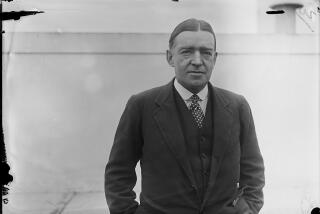Civil War-Era Shipwreck May Hold $180 Million in Treasure
- Share via
TAMPA, Fla. — Explorers believe they have found the sunken remains of an 1860s steamer that could yield the richest cargo ever recovered from a shipwreck: thousands of gold coins worth as much as $180 million.
The S.S. Republic was carrying 59 passengers and 20,000 $20 gold coins from New York to New Orleans when it sank in a hurricane off Savannah, Ga., on Oct. 25, 1865, according to newspaper accounts and historical records.
All the passengers boarded lifeboats and survived, but the coins -- intended to help pay for reconstruction of the South after the Civil War -- went to the bottom of the Atlantic Ocean with the Republic. An expert has estimated they would be worth from $120 million to $180 million today.
After searching for 12 years, Greg Stemm and John Morris of Odyssey Marine Explorations Inc. said Saturday that they found the wreck last month in 1,700 feet of water about 100 miles southeast of Savannah.
Documentation and excavation of the site using remote-operated equipment is set to begin next month.
“It’s almost like having a hand down there,” Stemm said of the robotic apparatus. “You can literally feel the pressure when you’re picking things up and moving them around.”
Because the wreck is in international waters, the Tampa-based company doesn’t need a permit to begin work. It has been granted federal “admiralty arrest” of the site to make it illegal for others to lay claim to it.
Odyssey crews combed 1,500 square miles of ocean using a robotic vehicle, sonar and magnetometer technology before finding the wreck they believe is the Republic, a side-wheel steamer that once served in the Union fleet.
“After all the years of searching for this particular shipwreck, finally finding it with just an incredible team of folks, it’s just an indescribable feeling,” Stemm said.
Odyssey, a publicly traded company founded in the mid-1990s, has a number of shipwreck search projects in various stages. Stemm and Morris have performed only one other deep-water excavation, that of a Spanish wreck in the Dry Tortugas that yielded about $5 million in gold and thousands of artifacts.
The company gained publicity recently when it entered a historic partnership with the British government to excavate the wreck of the HMS Sussex, which sank in 1694 off Gibraltar while leading a British fleet into the Mediterranean Sea for a war against France and its leader, Louis XIV.
Historians believe the 157-foot warship was carrying nine tons of gold coins aimed at buying the loyalty of the Duke of Savoy, a potential ally in southeastern France. The Sussex’s cargo could be more valuable than the Republic’s, but Odyssey will have to share it with England: The company will get 80% of the first $45 million and about 50% of the proceeds thereafter.
The company had planned to begin work on the Sussex next month but the Republic project will now take priority. The search crew of about 20 will expand to about 70 when the work begins.
“Its proximity to the U.S., the location of our equipment and the comparative weather windows between the Mediterranean and Atlantic make the choice to do the S.S. Republic project prior to the Sussex an easy one,” Morris said.
Donald H. Kagin, author of “Private Gold Coins and Patterns of the United States,” estimated that the $20 gold coins aboard the Republic would fetch between $6,000 and $9,000 each, based on the sale of coins from previous shipwrecks.
“That value would depend on the ultimate quality of the specimens, but if their condition proves to be comparable to other shipwreck coins from the period, it would make this the most valuable documented cargo ever recovered from a shipwreck,” Kagin said in a statement.
The richest haul previously came from the wreck of the S.S. Central America, which sank in a hurricane off the North Carolina coast in 1857 carrying a vast treasure of California gold.
The excavation of the Republic is expected to take a few months and cost the company from $1 million to $3 million.
More to Read
Sign up for Essential California
The most important California stories and recommendations in your inbox every morning.
You may occasionally receive promotional content from the Los Angeles Times.













